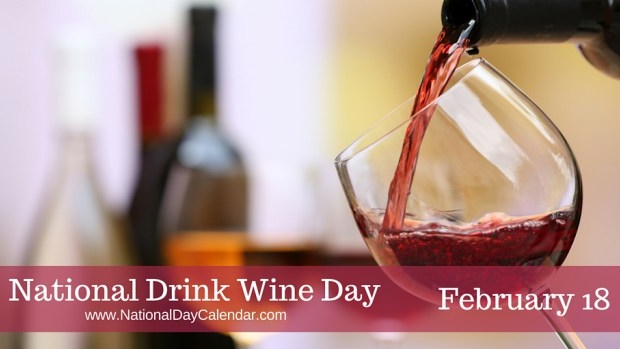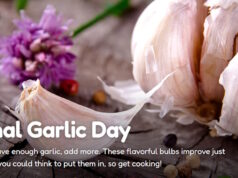
While February 18 is observed, annually, as National Drink Wine Day, it would be a shame to celebrate only one day a year. Perhaps this day is just a reminder to drink wine.
Wine does have its benefits after all. Moderate drinkers of wine have lower risks of liver disease, type II diabetes, certain kinds of cancers, heart attack and stroke. It also can reduce the bad cholesterol (LDL) and increase the good (HDL).
- Wine is about 8,000 years old. The exact beginnings are debated (with factions claiming “firsts” in both China and Mesopotamia), but most historians tend to agree that wine was discovered by accident. That’s likely why it is thought to come from the gods.
- The first known wine bottle dates back to 325 AD. It was found in 1867 near a vineyard in Speyer, Germany, inside one of two Roman stone sarcophaguses. The bottle is now on permanent display at the Historisches Museum der Pfalz.
- The growth of the wine industry exploded in Europe at the end of the Middle Ages. One reason was likely health related. In 1400, due to the Black Plague, which claimed more than half of Europe’s population, wine was considered safer to drink than water. Hundreds of years later, the renown scientist Louis Pasteur who studied micro-organisms and their effect on foods and beverages, seemed to confirm this theory, saying, “Wine can be considered with good reason as the most healthful and hygenic of all beverages.”
- In 1862, President Lincoln signed the first income tax in the United States into law. The tax scheme wasn’t terribly popular, so Congress slashed income tax rates in 1867, favoring excise taxes instead. From 1868 until the modern tax income tax system was established in 1913, 90% of all federal revenue came from taxes on liquor, beer, wine and tobacco.
- According to a 2016 Gallup poll, 32% of Americans who drink alcohol say they prefer wine (trailing beer drinkers at 46%). Total U.S. wine sales (including imports) approached $60 billion in 2016, the 24th consecutive year of growth for U.S. wine sales
- With 1.545 wine-related businesses per 10,000 residents, Portland, Oregon, is the most favorable U.S. city for wine lovers, according to Infogroup; it probably helps that Oregon has no state sales tax to boost prices. San Francisco ranks second on Infogroup’s list. Considered the wine production capital of the U.S., California boasts three cities (Sacramento and San Jose round out the group) on the list: according to the Wine Institute, the wine industry in California accounts for $15.2 billion in taxes each year, including annual local, state and federal business, excise taxes & personal taxes.
- Red Wines are well attributed to positive health benefits. It lowers your chances of having a stroke compared to nondrinkers. For men and women who drink moderately, it lessens their chance of developing Type 2 diabetes by 30%.
- Believe it or not, there are some people that have a fear of wine. It’s called “oenophobia”.
- Why do you store wine laying down? If the bottle is standing up, the cork could dry out and dwindle, possibly dropping into the wine.
- Women are more inclined to the effects of wine than men. This is partly because they have less enzymes in the stomach lining that is needed to break down alcohol simply.
- To get the same amount of antioxidants you find in wine, you would need to drink 20 glasses of apple juice or seven glasses of orange juice.
- THE US DRINKS MORE WINE THAN ANYONE ELSE. The world makes it, and we drink it down. While we still might not produce as much wine as France, Italy and Spain, that hasn’t stopped us from leapfrogging France for the top spot of consumption.
- IF WE’RE NOT DRINKING U.S. MADE WINE, THE CANADIANS AND BRITS PROBABLY ARE. We export more of our wine to Canada and Great Britain than the next 8 countries combined. On top of that, guess which countries we barely export any American vino to? You guessed it, France, Spain and Italy.
- MOST AMERICAN’S STILL BUY THEIR WINE AT GROCERY STORES. 50% in fact. Because wine is a grocery, after all.
- It is a common misconception that all wines improve with age. In fact, more than 90 percent of all wines should be consumed within one year. The three major collectibles that should age more than 10 years are: a great Châteaux of Bordeaux, the best producers of California Cabernet Sauvignon, and the finest producers of vintage port.
- The top three imported wines sold in the U.S. are Yellowtail (Australia), Cavit (Italy), and Concha y Toro (Chile).
- The term bouquet refers to the total scent of the wine. Aroma is the scent of the grapes. When wine tasters want to describe the bouquet and the aroma together, they use the term nose.
- As white wines age, they gain color. Red wines, on the other hand, lose color as they age. To analyze your glass of wine, hold the glass on an angle in front of a white background, such as a napkin or tablecloth. White wines can range from a pale yellow-green to a brownish hue. Reds begin at purple and scale all the way to brown.
- California has more Chardonnay grapes than anyplace in the world. It has been the most successful white grape in the state, yielding a wine of tremendous character and magnificent flavor. It is also the top selling variety in the United States.
- According to the U.S. Dietary Guidelines, there are 100 calories in a 5-ounce glass of wine (compared to 150 calories in a 12-ounce beer). Plus wine is a fat-free and cholesterol-free drink. Cheers!
Sources:












